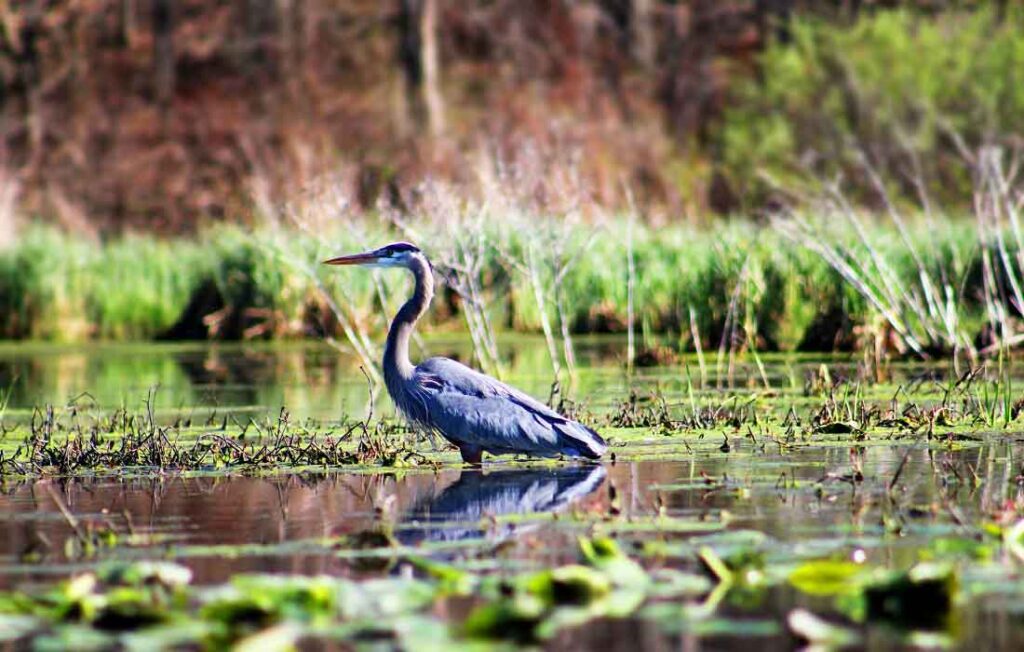At this very moment, the U.S. Supreme Court is deliberating Sackett v. Environmental Protection Agency (EPA), a landmark case that could reverse the EPA’s ability to regulate wetlands. Across the globe, we have already destroyed or degraded 4,000 miles of wetlands in just 20 years. These critical landscapes have been lost to property development, misguided engineering projects, agriculture, and the fossil fuel industry. Fortunately, these major losses have ushered in major lessons.
We’re discussing the basic terminology of wetlands, the important role of these habitats in protecting environmental and human health, and actions you can take to protect wetlands in the face of the current court case.
What Is a Wetland?
A wetland is an area of land where water is present on or beneath the surface of the soil. However, the amount of water in a wetland can change depending on the region and time of year.
Wetlands are readily recognized as swamps or marshes, such as the Louisiana Bayou, where water fills the landscape year-round. However, wetlands include any region where the soil is saturated with water at given times of the year. For example, vernal pools found in the western U.S. often remain dry during the summer and fall seasons.
Coastal wetlands are found along the coasts of a region and often contain components from both salt and freshwater sources. Salt marshes, bayous, and swamps, such as the coastal mangrove swamps of Florida, all serve as examples of coastal wetlands. On the other hand, inland wetlands are found away from shorelines, near rivers, streams, ponds, and lakes, or in low-lying regions where the soil may fill with water. Marshes, swamps and wet meadows are all examples of inland wetlands. Wetlands can be found in many regions across the globe. Did you know that wetlands can be found in every U.S. state?
Why Are Wetlands Important?
Wetlands and the wildlife they house provide a variety of benefits, or ecosystem services, that promote human well-being. Thus, wetlands play many important roles in protecting the health of the environment and humans alike.
Wildlife Nurseries
Wetlands serve as wildlife nurseries for many endangered species. Because of their unique location between water and land, salt and freshwater, wetlands shelter more than one-third of the United States’ vulnerable species. Without wetlands, a huge number of animals would simply cease to exist.
Flood Control
These landscapes also provide flood control by acting like sponges, soaking up water that comes in from changing tides or flooding rivers. Wetlands control floods much more effectively and efficiently than any floodwall. In fact, research demonstrates that every 100 acres of wetlands lost costs the U.S. an average of $1,840 per year due to losses in flood mitigation. This number jumps to $8,000 annually in developed areas.
Water Filtration
Further, wetlands help filter our water. If trees are the lungs of the planet, then wetlands are the kidneys. Wetlands naturally filter the water they contain, removing pollutants such as nitrogen and phosphorus along with contaminated sediment. In doing so, wetlands recharge drinkable water supplies. Clean and plentiful drinking water depends on healthy wetlands.
Storm Buffers
Wetlands even act as storm and wind buffers. According to research, the average protective effects of wetlands amount to $1.1 million per square-mile each year in storm protection services alone. Considering this, it makes sense that areas where wetlands have undergone tremendous erosion due to industrial and property development have struggled to weather storms.
Hurricane Ian cost Florida between $25 and $40 billion in property damages alone, emphasizing the devastating effects of wetland degradation. As climate change ushers in more extreme weather events, restoring and conserving wetlands will be critical to protect lives and homes.
These are just a few of the many benefits provided by wetlands. Some other services provided by wetlands include: providing fertile farmland and jobs, along with mitigating sea level rise.
The Future of Wetlands: Sackett v. EPA
It is clear that wetlands are of vital importance in promoting the health of the environment and human beings. Unfortunately, these crucial areas are under threat in the Supreme Court in the case of Sackett v. EPA.
The case involves Michael and Chantell Sackett, a couple that bought a property located on a wetland in Idaho. Considering the many ecosystem services they provide, wetlands are regulated by the EPA under the Clean Water Act. However, the Sacketts challenge the EPA’s authority to regulate these crucial environments, and they are backed by powerful polluting industries. The case made it to the Supreme Court, where the fate of wetlands now faces a national audience. The verdict could mean a loss of protection for already declining wetlands. This could hold major repercussions for our health along with the health of the environment.
In the face of these troubling possibilities, here are some ways you can help:
- Take simple actions to wetland degradation exploitation such voting, signing petitions, and speaking up about the importance of these landscapes.
- Pick up litter and use phosphate and bleach-free cleaning products to prevent wetland pollution and help keep our water supplies clean.
- Visit wetlands near you to support those actively preserving and maintaining these beautiful ecosystems.




